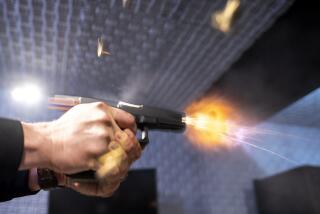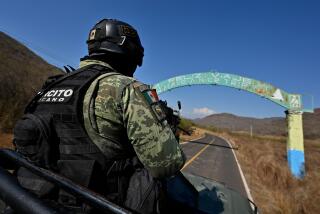COLUMN ONE : Ordnance: High Tech’s Gory Side : The new generation of weapons and ammunition, developed since the Vietnam War, can destroy tanks, penetrate bunkers and kill or maim troops with deadly precision.
- Share via
They sound like a cast of cartoon characters: Adam, Beehive and Bouncing Betty. Yet they are among the most lethal ordnance ever deployed in battle.
Adam, a member of the Army’s “family of scatterable mines,” is packed with electronic detectors and a charge just large enough to puncture a liver. Beehive spews out 8,800 tiny flechettes--razor sharp darts that cause deep wounds. Bouncing Betty and its sister ordnance systems are designed to detonate at groin level, close to vital organs.
The Gulf War has raised public awareness of many high technology American weapons, such as Stealth fighters and Patriot missiles. But with much less fanfare, the Pentagon since the Vietnam War has developed a new generation of ordnance to destroy tanks, penetrate bunkers and kill troops with deadly effectiveness.
The mechanics of death and destruction are a grim affair. The military’s scientific approach and its philosophies--for example, its preference for wounding vital organs over blowing off limbs--can be deeply disquieting to anybody who imagines such matters are left to chance. Many people would rather not know about the gruesome details.
“When my wife meets new friends and they ask, ‘What does your husband do?’ she tells them, ‘He is a business executive at an ordnance manufacturer,’ and they act horrified,” one official lamented recently. “And they give her a very bad time. People don’t like to think about ordnance.”
People in the business of thinking up such weapons, fine-tuning them and producing them for maximum injury on the battlefield, are deeply committed to what they do. In war, the enemy must be destroyed. In the end, that will save American lives, they say.
In the Persian Gulf War, Saddam Hussein’s notorious arsenal of ground weapons may be no match for the artillery shells, rockets and mines that the U.S. Army has likely begun to use--weapons so revolutionized in the last two decades that many experts believe they are the most deadly in the world.
“Lethality and accuracy are the two areas that have shown the most improvements,” said Jay Sculley, former assistant secretary of the Army.
The same advances in metallurgy, electronics miniaturization and computer modeling that have improved consumer products have also made ordnance more deadly. Fragmentation is more precise. Weapons find their targets with greater accuracy. And the trauma inflicted on human tissue is more calculated.
Only about 20% of the human body consists of vital organs and tissues--such as the brain, major arteries and glands--injury to which will incapacitate a soldier in battle. So a major objective of weapons experts has been to develop ordnance that will increase the probability of a small injury to a vital organ, rather than a major injury to a nonvital part of the body.
It is ordnance that determines winners and losers on the battlefield. An estimated 60% of all deaths in land warfare are caused by artillery; a large proportion of the remainder by mortar fire.
The destructiveness of such weapons is documented in a series of classified handbooks, called J-MEMS or joint munitions effectiveness manuals. The manuals tell commanders at the front line how much carnage they can anticipate when using certain ordnance.
The manual was derived from a series of calculations on ballistic wounds pioneered by the late Marguerite Rogers, a Navy bomb expert, and Joseph Sperrarzza, an Army ballistic wound specialist. Their research resulted in tables and formulas that could determine the probability of a soldier being incapacitated within a given number of seconds, based upon such variables as weapon fragment size and velocity, among others.
That work was followed by a study of 7,801 casualties of the Vietnam War to determine which types of wounds were most debilitating. The Vietnam War analysis by Sperrarzza eventually led the military to supply protective vests to American soldiers--believed to be 25% more effective in reducing wounds than earlier such gear.
Battlefields are clearly getting more lethal. Since fragments are smaller, they travel at far higher velocities for any given explosive charge; with fragments so much smaller, there can be many more of them. That has significantly increased the so-called “probability of kill.”
Until the 1970s, cannons had changed little since their introduction during the Sixth Crusade in 1228. A propellent charge hurtles a projectile at high speed out of a tube toward a target. The shell explodes, destroying targets either with shrapnel or with the percussion of the blast.
The problem with a conventional cannon is that it is not terribly accurate, and its fragmentation or blast can kill only over a limited area. The solution has been to improve accuracy with precision guidance and to increase the fragmentation effect by filling the shells with small sub-munitions.
Hence, The Army has deployed the “improved conventional munition” or ICM round. These 155-millimeter artillery shells contain up to 88 bomblets that cover a huge area of a battlefield. They are capable of destroying lightly armored vehicles, such as personnel carriers, with hollow-point, armor-piercing heads and of incapacitating soldiers with secondary fragmentation.
ICM bomblets have an estimated 50% probability of killing a soldier at 15 meters. By spreading 88 sub-munitions, rather than a single large blast, the ICM can kill four times as many soldiers.
Yet in relative terms, the blast from an artillery shell or bomb is not particularly lethal.
The chance of dying from a blast shock does not begin until the pressure reaches 42 pounds per square inch; the probability of death rises to 90% at 90 pounds per square inch, according to Robert G.S. (Bud) Sewell, a physicist who designed weapons at the China Lake Naval Weapons Center for three decades. By comparison, human eardrums are pierced at a pressure of just a half-pound per square inch.
“Blast is the most inefficient kill mechanism there is for people,” Sewell said.
On the other end of the spectrum is the white phosphorus howitzer shell, which bursts high-velocity, burning white phosphorus particles over a limited area. The fragments can continue to burn hours after they have penetrated a soldier’s body, creating deep lesions.
Wounds from such incendiary or high-explosive weapons, however, are not always intended to cause death.
“You would rather have casualties (injuries) than death,” said Tom Amlie, former technical director of the China Lake center. “Injury raises hell with the enemy’s logistics load. With the dead, he doesn’t have to do anything. But with a wounded (soldier), he has a huge logistics problem, requiring all kinds of transportation and medical care. And if he doesn’t care for his wounded, the morale of his troops will just go to hell.”
While many people find such thinking abhorrent, weapons designers argue that the intention is to save the lives of American troops at the expense of the enemy. “A lot of people come unglued,” Sewell said. “But it is a job that has to be done. We all deal with it in our own way.”
Taking the concept of bomblet-type weapons such as the ICM one step further are so-called bouncing or bounding ordnance systems, designed to detonate at groin level and spray shrapnel at an elevation that is more damaging to vital human organs.
The Adam, dropped out of a howitzer shell, has detectors sensitive to touch, pressure or magnetic fields. Once triggered, a propellent charge launches the mine upward before it detonates. With its advanced electronics, Adam can be remotely detonated or remotely deactivated to avoid posing a hazard to American troops.
But such anti-personnel weapons are only as good as the uniformity of the shrapnel that they disperse.
Metallurgical science has advanced substantially since World War II, when a bomb could produce huge chunks of metal that would have little velocity, or very high speed, dust-size particles capable of inflicting only minor damage to human tissue.
By using sophisticated heat-treating processes and high-carbon steels, however, arms manufacturers have developed shells and submunitions capable of shattering into uniform chunks of lethal metal, much like a tempered automobile windshield shatters into perfect cubes upon impact.
Charles Bernard, an ordnance expert and former assistant deputy undersecretary of defense for land warfare, estimates that just several grains of metal--a cube measuring one-tenth of an inch across each face--are adequate to cause serious injury at velocities of 2,000 to 4,000 feet per second. (There are 7,000 grains in a pound.)
Perhaps the ultimate concept in improved fragmentation is the Beehive system, which has no fragments at all. The Beehive shell is fired out of a cannon and spins at high velocity, spitting out 8,800 flechettes--tiny darts with razor edges capable of causing deep wounds.
The development of these weapons--and the breakthrough finding that tiny, high-velocity fragments were more effective than larger, slow fragments--followed a series of tests during the 1950s and 1960s, in which the Army shot hundreds of goats to study wound tracks.
Much of the research was conducted at the China Lake Naval Weapons Center in California, the Picatinny Army Arsenal in New Jersey and the Aberdeen Proving Grounds in Maryland.
“The reason we used goats was that their internal structure is very similar to the human, and they were cheap--just $10 a head. But don’t put my name in the paper, because people get upset,” said a scientist involved in the tests. “These goats were very old and ready to die anyway. You know in France, they used pigs and then they fed them to the poor. We didn’t do that. We cremated them.”
Indeed, testing such lethal weapons has always been a tricky business.
Austin, the China Lake scientist, recalls that in the early days of ordnance testing, he once checked the percussive effects of a bomb by walking 50 feet closer to ground zero in a series of explosions.
“By the time I was knocked off my feet, I said, ‘OK, that’s all I can stand,’ ” he recalled. Austin now is deaf in one ear.
Today, the lethality of such weapons is measured in more sophisticated ways, including the use of dummies much like those employed in car-crash tests, according to John Maniatakis, vice president at NI Industries, an ordnance firm. The dummies are arranged in various positions on the ground or in vehicles and then attacked with ordnance.
Anti-personnel weapons are just one area, however, in which conventional ordnance has improved. The Army also has made important strides in ordnance to attack bunkers and defeat tank armor, experts say.
The Iraqi army is said to be well protected in formidable concrete bunkers. But U.S. experts in building and defeating such bunkers are dubious.
“I have never seen a concrete structure that I could not penetrate,” said Austin, the China Lake scientist and one of the nation’s leading experts on ordnance designed to penetrate concrete and stone.
Austin said the concrete in most Middle Eastern construction projects is poorly mixed and made in sections, not continuously cast, resulting in weak structures by U.S. standards.
Concrete used for typical U.S. sidewalks has a compressive strength of 2,500 pounds per square inch; U.S. concrete for bridges or military installations has a compressive strength of more than 4,000 pounds per square inch.
Middle Eastern concrete is on a par with U.S. sidewalks, making it easier to penetrate, Austin said. Shells fired by naval guns or bombs dropped by aircraft have hardened steel noses that can push their way through such concrete tens of feet thick, Austin said.
Once the bomb has pushed through, a time-delay fuse detonates, blasting occupants inside the bunker. But even if the bomb fails to make it all the way through, the detonation will cause the interior concrete surface to “spall,” spraying occupants with high velocity concrete.
Another relatively new high-technology weapon for destroying structures is the fuel-air explosive, which disperses highly flammable liquid over a large area and then detonates it, creating a huge pressure shock that can knock down buildings and exceed the 90-pound-per-square-inch lethality limit for humans.
The area of greatest strides has been in ordnance that defeats armor. The Army’s multiple-launch rocket system can disperse 644 anti-tank mines, each of which fires a “shape-charge” projectile when a tank passes nearby.
A shape charge is an explosive surrounding a cone of metal; on detonation it creates a jet traveling at up to 25,000 feet per second that cuts through armor. Once through the armor, the jet sends a blinding flash of light into the tank, followed by shattered fragments of tank armor flying at high velocity, according to Robert J. Eichelberger, the physicist renowned in ordnance circles for pioneering early shape-charge weapons.
FUEL-AIR EXPLOSIVE
The blast from a fuel-air explosive creates a high-pressure shock wave that can flatten buildings and detonate mines. The bomb was used in the Vietnam War
1. Bomb release
2. Fuse detonates at a height of about 30 feet
3. Cloud of fuel about 60 feet across and eight feet thick forms and falls to the ground
4. Fuel is ignited by second explosive charge; fireball consumes oxygen and incinerates everything in range
CBU-55B cluster bomb
Bomb contains three fuel-air explosive devices. Each weighs 100 lbs. and is filled with 73 lbs. of ethylene oxide fuel.
Source: Jane’s Air-Launched Weapons
More to Read
Sign up for Essential California
The most important California stories and recommendations in your inbox every morning.
You may occasionally receive promotional content from the Los Angeles Times.











